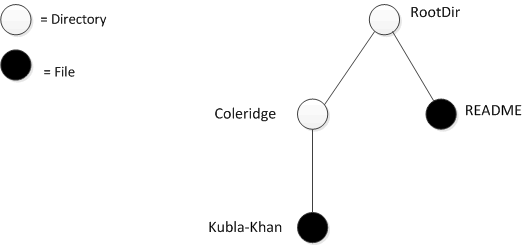This page presents a very simple client to access a server that implements the file system we developed in Slice for a Simple File System. The Ruby code shown here hardly differs from the code you would write for an ordinary Ruby program. This is one of the biggest advantages of using Ice: accessing a remote object is as easy as accessing an ordinary, local Ruby object. This allows you to put your effort where you should, namely, into developing your application logic instead of having to struggle with arcane networking APIs.
We now have seen enough of the client-side Ruby mapping to develop a complete client to access our remote file system. For reference, here is the Slice definition once more:
module Filesystem {
interface Node {
idempotent string name();
};
exception GenericError {
string reason;
};
sequence<string> Lines;
interface File extends Node {
idempotent Lines read();
idempotent void write(Lines text) throws GenericError;
};
sequence<Node*> NodeSeq;
interface Directory extends Node {
idempotent NodeSeq list();
};
};
To exercise the file system, the client does a recursive listing of the file system, starting at the root directory. For each node in the file system, the client shows the name of the node and whether that node is a file or directory. If the node is a file, the client retrieves the contents of the file and prints them.
The body of the client code looks as follows:
require 'Filesystem.rb'
# Recursively print the contents of directory "dir"
# in tree fashion. For files, show the contents of
# each file. The "depth" parameter is the current
# nesting level (for indentation).
def listRecursive(dir, depth)
indent = ''
depth = depth + 1
for i in (0...depth)
indent += "\t"
end
contents = dir.list()
for node in contents
subdir = Filesystem::DirectoryPrx::checkedCast(node)
file = Filesystem::FilePrx::uncheckedCast(node)
print indent + node.name() + " "
if subdir
puts "(directory):"
listRecursive(subdir, depth)
else
puts "(file):"
text = file.read()
for line in text
puts indent + "\t" + line
end
end
end
end
status = 0
ic = nil
begin
# Create a communicator
#
ic = Ice::initialize(ARGV)
# Create a proxy for the root directory
#
obj = ic.stringToProxy("RootDir:default -p 10000")
# Down-cast the proxy to a Directory proxy
#
rootDir = Filesystem::DirectoryPrx::checkedCast(obj)
# Recursively list the contents of the root directory
#
puts "Contents of root directory:"
listRecursive(rootDir, 0)
rescue => ex
puts ex
print ex.backtrace.join("\n")
status = 1
end
if ic
# Clean up
#
begin
ic.destroy()
rescue => ex
puts ex
print ex.backtrace.join("\n")
status = 1
end
end
exit(status)
The program first defines the listRecursive function, which is a helper function to print the contents of the file system, and the main program follows. Let us look at the main program first:
- The structure of the code follows what we saw in Hello World Application. After initializing the run time, the client creates a proxy to the root directory of the file system. For this example, we assume that the server runs on the local host and listens using the default protocol (TCP/IP) at port 10000. The object identity of the root directory is known to be
RootDir. - The client down-casts the proxy to
DirectoryPrxand passes that proxy tolistRecursive, which prints the contents of the file system.
Most of the work happens in listRecursive. The function is passed a proxy to a directory to list, and an indent level. (The indent level increments with each recursive call and allows the code to print the name of each node at an indent level that corresponds to the depth of the tree at that node.) listRecursive calls the list operation on the directory and iterates over the returned sequence of nodes:
- The code does a
checkedCastto narrow theNodeproxy to aDirectoryproxy, as well as anuncheckedCastto narrow theNodeproxy to aFileproxy. Exactly one of those casts will succeed, so there is no need to callcheckedCasttwice: if theNodeis-aDirectory, the code uses theDirectoryPrxreturned by thecheckedCast; if thecheckedCastfails, we know that the Node is-a File and, therefore, anuncheckedCastis sufficient to get aFilePrx.
In general, if you know that a down-cast to a specific type will succeed, it is preferable to use anuncheckedCastinstead of acheckedCastbecause anuncheckedCastdoes not incur any network traffic. - The code prints the name of the file or directory and then, depending on which cast succeeded, prints
"(directory)"or"(file)"following the name. - The code checks the type of the node:
- If it is a directory, the code recurses, incrementing the indent level.
- If it is a file, the code calls the
readoperation on the file to retrieve the file contents and then iterates over the returned sequence of lines, printing each line.
Assume that we have a small file system consisting of a two files and a a directory as follows:
A small file system.
The output produced by the client for this file system is:
Contents of root directory: README (file): This file system contains a collection of poetry. Coleridge (directory): Kubla_Khan (file): In Xanadu did Kubla Khan A stately pleasure-dome decree: Where Alph, the sacred river, ran Through caverns measureless to man Down to a sunless sea.
Note that, so far, our client is not very sophisticated:
- The protocol and address information are hard-wired into the code.
- The client makes more remote procedure calls than strictly necessary; with minor redesign of the Slice definitions, many of these calls can be avoided.
We will see how to address these shortcomings in our discussions of IceGrid and object life cycle.


